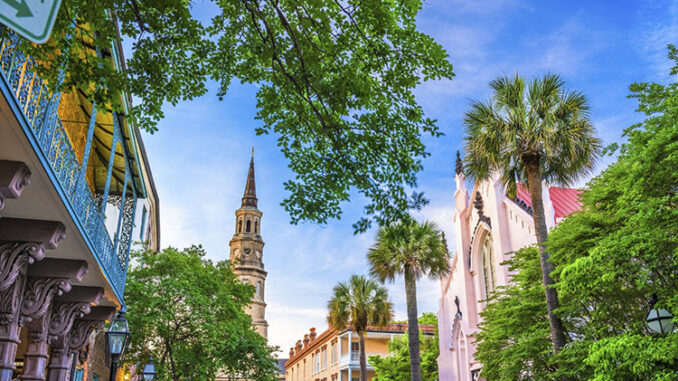
By Georgina Cruz
Charleston, South Carolina, is a southern city that offers not only a visual feast with its elegant historic neighborhoods, but also a banquet of culinary delights with chefs who find inspiration in British, French, African and Caribbean influences to créate specialties of the cuisine of the South.
Nobody leaves Charleston without tasting the delicious crab soups, the southern grits, the shrimps in stews, or fried or prepared in other delectable ways (accompanied with rice they are delightful), and the always refreshing mint juleps and much more.
The jewel of South Carolina, Charleston is a refined city –it has mansions that date from before the Civil War in the U.S., as well as historic quarters with beautiful gardens filled with jasmine, azaleas and magnolias.
Visitors sometimes hear of a Charleston high society lady who was asked why she did not travel much and she answered, “Why travel? I am already here.”
And certainly there are few places in the world that combine the beauty and history of the South of the U.S. like Charleston does.
Founded in 1670 by British colonists on a peninsula in the Atlantic, the city next to the Cooper and Ashley Rivers played an important role in the American Revolution, with its name changed from the original “Charles Towne” (in honor of Charles II, king of England) to Charleston, in 1783, after gaining independence.
Around that time, Charleston was visited by George Washington, the first president of the U.S., and it was an era when big plantations dedicated to planting cotton, rice and other crops flourished in the city’s surroundings.
The owners of those plantations, who benefited from slave labor, made Charleston side with the Confederates during the Civil War, and it was precisely in the local Fort Sumter, that that war began with the rebels taking the fort from Union forces.
History lovers are able to visit this fort on an excursión from Fort Sumter Tours (www.fortsumtertours.com) via ferry from the Port of Charleston. Fort Sumter, now a National Park, has ample fortifications, cannons and exhibits.
Visitors interested in touring historic mansions restored by the non-profit Historic Charleston Foundation may opt to go to the Nathaniel Russell House, 51 Meeting Street. Built in 1808 in Federal style, the house has period furnishings –and a harp in one of the salons where the family received members of society in the 19th century as well as lovely gardens.
Other pre-Civil War mansions that are open to the public include the Calhoun Mansion, 16 Meeting Street. In Italian style, it has 35 rooms including a ballroom and 35 chimneys, gardens, and views of the port. Still other historic mansions include the Edmondston-Alston House, 21 East Battery; Drayton Hall, 3380 Ashley River Road; and Middleton Place, 4300 Ashley River Road.
Boone Hall Plantation & Gardens, on Long Point Road (www.boonehallplantation.com) is one of the oldest plantations still standing. It has a portio with big white columns, an oak alley leading to the entrance, and gardens with camellias, azaleas and many varieties of roses. The soil is still cultivated here following the agricultural traditions of the South of the U.S. –although instead of cotton, they grow strawberries, tomatoes, peaches and pines that are sold for Christmas trees. Among the points of interest that may be visited are the slave quarters (that are listed in the Registry of Historic Places of the United States). A visit to Boone Hall Plantation also offers opportunities to see African-American exhibits and a butterfly Pavilion as well as tasting Southern specialties in Serena’s Kitchen.
Other Charleston points of interest include:
* The South Carolina Aquarium – This Aquarium has a 350,000-gallon tank with sharks, sea turtles and other fascinating marine creatures. The Aquarium also has an aviary with exotic birds and a forest with regional fauna (www.scaquarium.org).
* The Gibbes Museum of Art – Established in 1858, this museum has works by artists from Charleston and its surroundings including a superb collection of art by 20th century African-American artists. The museum is at 135 Meeting Street (www.gibbesmuseum.org).
* The Charleston Museum – Founded in 1773, this museum is one of the first in the U.S. and is dedicated to the natural and cultural history of South Carolina from the prehistoric era to the present with all manner of historic artifacts. Among the objects on exhibition is a gigantic whale skeleton. The Charleston Museum is at 360 Meeting Street (www.Charlestonmuseum.com).
Information: www.CharlestonCVB.com.

